Day of military glory of Russia. The destruction of the Swedish army in the Battle of Poltava
prehistory
The just desire of the Russian state to reclaim the original Russian lands on the shores of the Gulf of Finland and at the mouth of the Neva and thereby gain access to the Baltic Sea, which Russia needed for military-strategic and economic reasons, resulted in a long and bloody Northern War with the Swedish Empire, which considered the Baltic its "lake". Russia was supported by Denmark, Saxony and Rzeczpospolita, who were also dissatisfied with the hegemony of Sweden in the Baltic.
The beginning of the war was a failure for Russia and its allies. The young Swedish king and talented commander Karl XII brought a lightning strike out of the war Denmark - the only power of the Northern Union (the anti-Swedish coalition consisting of the Russian state, Rzecz Pospolita, Saxony and Denmark), which had a navy. Then the Swedes defeated the Russian army near Narva. However, the Swedish king made a strategic mistake. He did not complete the defeat of the Russian state, forcing him to peace, and carried away by the war with the Polish king and the Saxon Elector Augustus II, chasing him through the territory of the Commonwealth. The Swedish king underestimated the Russian kingdom and organizational skills, determination and the will of Peter. He decided that his main enemy was the Saxon Elector and the Polish King Augustus II.
This allowed Tsar Peter to "work on the mistakes." The Russian Tsar strengthened the cadre of the army by saturating it with national cadres (previously the stake was on foreign military specialists). They strengthened the army at a rapid pace, built a fleet, and developed industry. While the main forces of the Swedish army, led by the king, fought in Poland, the Russian army began to crowd out the enemy in the Baltic states and captured the mouth of the Neva River. In 1703, the fortified city of St. Petersburg was founded. In the same year they created the Baltic Fleet and laid the foundation for the Russian fleet in the Baltic - Kronstadt. In 1704, Russian troops captured Derpt (Yuryev) and Narva.
As a result, when Karl again turned the army against the Russians, he met another army. An army that had already won victories more than once and was ready to compete with the forces of a powerful adversary (the Swedish army before Poltava was considered one of the best, if not the best, in Europe). In the moral, organizational and technical condition of the Russian army qualitatively changed for the better. Russia entrenched in the Baltic and was ready for new battles.
Russian campaign of Charles XII
In the meantime, the Swedes were able to end Poland and Saxony. Karl planted his protege Stanislav Leschinsky in Poland. In 1706, the Swedes invaded Saxony, and the Polish king and the Saxon elector Augustus II concluded a peace agreement with Sweden, emerging from the war. After that, Russia was left without allies. In the spring and summer of 1707, Karl XII prepared his army, located in Saxony, for the Russian campaign. The Swedish king managed to make up for the losses and significantly strengthened his troops. At the same time, the Swedish king cherished a plan for a large-scale invasion of Russia with the participation of the Turkish troops, the Crimean Khanate, the Polish puppet regime of Stanislav Leschinsky and the Cossacks of the hetman the traitor Mazepa. He planned to take Russia into giant “ticks” and forever discard Moscow from the Baltic Sea. However, this idea failed. The Turks did not want to fight during this period, and the betrayal of Mazepa did not lead to a large scale deposition of the Cossacks and an uprising in the south. A bunch of senior traitors could not turn the people against Moscow.
Karl was not embarrassed (he dreamed of the glory of Alexander the Great) and he began a campaign with the available forces. The Swedish army began the march in September 1707. In November, the Swedes forced the Vistula, Menshikov retreated from Warsaw to the Narew River. Then the Swedish army made a difficult transition on the actual off-road through the Mazury bogs and in February 1708 reached the city of Grodno, the Russian troops withdrew to Minsk. Exhausted by heavy marches on the road, the Swedish army was forced to stop at the "winter apartments". In June 1708, the Swedish army continued its march along the Smolensk-Moscow line. In late June, the Swedes crossed the Berezina south of Borisov. Simultaneously, the corps of Levengaupta with a huge wagon train went south from Riga. In July, the Swedish army defeated the Russian troops under Golovchin. The Russian army retreated beyond the Dnieper, Karl XII occupied Mogilev and captured the ferry across the Dnieper.
Further advancement of the Swedish army slowed down dramatically. Tsar Peter applied the old tactics of the Scythians - the scorched earth tactics. Swedish troops had to move through the devastated terrain, experiencing an acute shortage of food and fodder. 11-13 September 1708 was in the small Smolensk village Starishi held a military council of the Swedish king with his generals. The question of the further actions of the army was decided: to continue moving to Smolensk and Moscow, or to go south to Little Russia, where Mazepa promised full support. The movement of the Swedish army in the devastated area threatened with hunger. Winter was approaching, the Swedish army needed rest and food. And without heavy artillery, and the supplies that General Lewenhaupt was supposed to bring, it was almost impossible to take Smolensk. As a result, they decided to go south, especially, Hetman Mazepa promised winter apartments, food and assistance to 50-thousand. Little Russian troops.
The defeat of the Levengaupt corps 28 September (9 October) 1708 in the battle near the village of Lesnoy finally buried the plans of the Swedish command to march on Moscow during the campaign 1708 of the year. It was a serious victory, not for nothing that Tsar Peter Alekseevich called her “the mother of the Poltava battle”. The Swedes lost hope of strong reinforcements - about 9 thousand Swedes were killed, wounded and captured. By King Karl, General Lewenhaupt was able to bring only about 6 thousands of demoralized soldiers. The Russians seized an artillery park, a huge wagon train with a three-month supply of food and ammunition. Karl had no choice but to turn south.
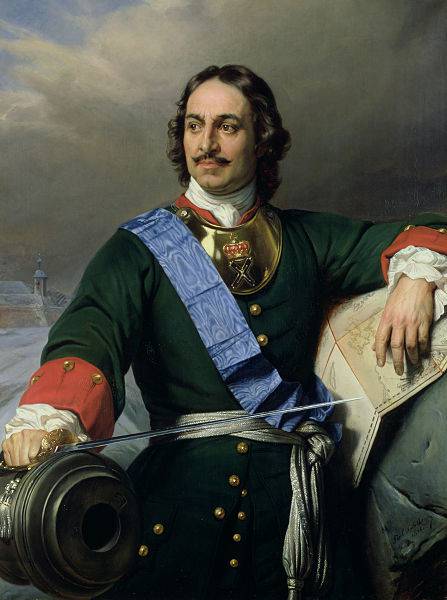
Portrait of Peter I. Artist Paul Delaroche
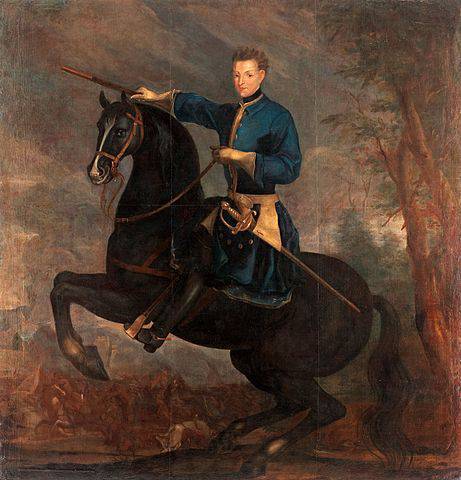
Swedish king Charles XII
Opposition in South Russia
And in the south everything was not as good as in the words of the traitor Mazepa. Of the many thousands of Cossacks, Mazepa managed to bring only a few thousand people, and even these Cossacks did not want to fight for the Swedes and fled at the first opportunity. Menshikov beat Karl XII's avant-garde, took Baturin and burned the reserves there. Swedes only got ashes. Karl had to move further south, making the population angry with looting. In November, the Swedes entered Romny, where they stopped for the winter.
In winter, the situation has not improved. Swedish troops are located in the area of Gadyach, Romain, Priluk, Lukhovits and Lubin. Russian troops stationed east of this area, closing the approaches to Belgorod and Kursk. The bases of our troops were Sumy, Lebedin and Akhtyrka. The dispersion of the Swedish army was due to the inability to locate an army in one or two cities and the need for constant requisition of food and fodder from the local population. The Swedes were losing people in constant small skirmishes. Swedish troops were “bored” not only by the “parties” sent by the Russian generals, but also by peasants and citizens, dissatisfied with the activities of the interventionists. For example, in mid-November, three cavalry and one infantry regiments of the enemy approached the small town of Bold in the hope of winter apartments. Menshikov, learning of this, brought the dragoon regiments to help the townspeople. The Russian dragoons, along with the commoners, defeated the Swedes: around 900, a man was killed and captured. The whole wagon train has become a trophy of Russian troops. When the Swedish king Charles with the main forces arrived at the Bold, his population, having decided that the resistance was hopeless, left the town. Karl XII, on the advice of Mazepa, burned the rebellious city. In December, the Swedes captured the weakly fortified city of Tern, massacred more than a thousand residents and burned the settlement. Large losses - about 3 thousand people, the Swedes suffered during the storming of the fortress Veprik.
Both armies suffered losses not only during clashes and storms, but also from an unusually harsh winter. In 1708, severe frost swept across Europe and caused enormous damage to gardens and crops. As a rule, mild winter in Little Russia is unusually cold. Many soldiers froze or frostbit face, hands and feet. In this case, the Swedes suffered more serious losses. The ammunition of the Swedish soldiers, which had become heavily worn out after leaving Saxony, did not save them from the cold. Contemporaries from the Swedish camp left a lot of evidence about this disaster. The representative of S. Leshchinsky at the headquarters of Charles XII Poniatowski wrote: “Before coming to Gadyach, the Swedes lost three thousand soldiers who were frozen dead; besides, all ministers with carts and many horses. "
The Swedish army was cut off from the military-industrial base, the fleet and began to experience a lack of cannonballs, lead and gunpowder. It was impossible to replenish the artillery park. Russian troops systematically crowded the enemy, threatening to cut off the Swedes from the Dnieper. Karl could not impose on Peter the general battle in which he hoped to crush the Russians and open the way for an offensive against Moscow.
Thus, during the winter 1708 - 1709. Russian troops, avoiding the general battle, continued to harry the forces of the Swedish army in local battles. In the spring of 1709, the city of Karl XII decided to renew the offensive on Moscow through Kharkov and Belgorod. But before that, he decided to take the fortress of Poltava. The Swedish army has approached it with a force of 35 in thousands of people with 32 guns, not counting a small number of Mazepians and Zaporozhians. Poltava stood on the high bank of the Vorskla River. The city was protected by a shaft with a palisade. The garrison, commanded by Colonel Alexei Kelin, consisted of 6,5-7 thousand soldiers, Cossacks and militia. The fortress had 28 guns.
The Swedes, having no artillery and ammunition for the siege, tried to take the fortress by storm. From the first days of the siege, they began to storm Poltava time after time. Its defenders only in April month repelled 12 enemy attacks, often making daring and successful forays themselves. The Russian army was able to hold the garrison of Poltava with people and gunpowder. As a result, the heroic defense of Poltava gave the Russians a gain in time.
Thus, the strategic situation for the Swedish army continued to deteriorate. Poltava could not take, despite the long siege and heavy losses. In May, 1709 was defeated by the Lithuanian hetman Jan Sapega (a supporter of Stanislav Leschinsky), which dispelled the hopes of the Swedes for help from the Polish-Lithuanian Commonwealth. Menshikov was able to transfer reinforcements to Poltava, the Swedish army was in actual surroundings. Carl's only hope was a decisive battle. He believed in the invincibility of his army and victory over the "Russian barbarians", despite their superiority in the number of people and guns.
The situation before the battle
Peter decided it was time for a general battle. 13 (24) June, our troops planned to break the blockade of Poltava. On the eve of the king sent the commandant of the fortress Kelin order that the defenders of the fortress at the same time the attack, which inflicted the main forces of the Russian army, made a sortie. However, the plan of attack broke the weather: heavy rain raised the water level in Vorskla so much that the operation was canceled.
But the bad weather operation was compensated by a successful attack in the Old Senjars. The Russian colonel Yurlov, who was in captivity, was able to secretly notify the command that in Stariy Senzharas, where Russian prisoners were kept, “the enemy is not fully populated”. 14 (25) June sent a dragoon to Lieutenant General Genskina there. The Russian dragoons stormed the city and liberated 1300 prisoners, destroying 700 enemy soldiers and officers. Among the Russian trophies was the Swedish treasury - 200 thousand thalers. The relatively insignificant losses of the Russian troops - 230 killed and wounded, were an indicator of the decline in combat skills and the spirit of the Swedish troops.
16 (27) June 1709, the Russian Military Council confirmed the need for a general battle. On the same day, the Swedish monarch was wounded in the leg. According to the version presented in the “History of the Holy War”, Karl and his retinue checked posts and accidentally ran into a group of Cossacks. The king personally killed one of the Cossacks, but during the fight a bullet hit him in the leg. According to contemporaries of the battle, when the king heard that several enemies had crossed the river, he, taking with him several Drabants (bodyguards), attacked and overturned them. During his return he was wounded by a shotgun. This event showed the courage of the Swedish king and his irresponsibility. Karl XII led his army to distant lands from his native Sweden and found himself on the verge of disaster in Little Russia, which, it would seem, should have thought about how to carry his legs and save the soldiers, and not risk his life in small skirmishes. You cannot deny Karl’s personal courage, he was a brave man, but he lacked wisdom.
Meanwhile, the moment of the decisive battle was approaching. Even before Charles was injured, 15 (26) of June, part of the Russian army forced Vorskla, which previously divided the two armies. When Renschild reported this to the king, he conveyed that the field marshal could act on his own. Since the time of the Battle of Forestry, Karl has been overwhelmed with bouts of indifference, it was such a moment. In fact, the Swedes almost did not offer resistance to the Russian forces that were being forwarded, although the water line was convenient for a counterattack and defense. 19-20 of June (30 of June - 1 of July) on the opposite bank of the river, Tsar Peter Alekseevich crossed with the main forces.
The Swedish king Charles XII, who always adhered to offensive tactics, showed no interest in the engineering preparation of the future battlefield. Karl believed that the Russian army would be passive, and would mostly be defensive, which would allow him to break through the enemy defenses and defeat him with a decisive attack. The main concern of Karl was to secure the rear, that is, to deprive the possibility of the garrison of Poltava to make a sortie at the moment when the Swedish army would be engrossed in a battle with the army of Peter. For this, Karl needed to take a fortress before the start of the general battle. June 21 (July 2) the Swedish command organized the next storming of Poltava. The Swedes again prepared undermining, laid the barrels of gunpowder, but, as before, there was no explosion - the besieged safely removed the explosives. On the night of June 22 (July 3), the Swedes went to the assault, which almost ended in victory: "... in many places the enemy rose on the shaft, but the commandant showed indescribable courage, because he himself was present and repulsed in all the right places." At the critical moment, the residents of the city also helped: “The residents of Poltava were all on the shaft; the wives, although they were not in the fire on the shaft, only brought stones and so on. ” The assault failed this time too. The Swedes suffered heavy losses and did not receive security guarantees for the rear.
Meanwhile, Russian troops built a fortified camp at the crossing point - the village of Petrovka, located 8 versts north of Poltava. After examining the terrain, the Russian tsar ordered the army to be moved closer to the enemy’s disposition. Peter decided that the open area at Petrovka gives the enemy a great advantage, since the Swedish army had previously been distinguished for its high maneuverability and ability to rebuild during the battle. Based on the experience of the battles of Forest, it was obvious that the Swedes lose this advantage in conditions when it is necessary to fight in conditions of rugged wooded areas, limiting the maneuver.
This terrain was in the area of the village Yakovtsy. Here, five kilometers from the enemy, the Russian 25 June (6 July) began to build a new fortified camp. It was reinforced by the six redoubts built in front of the camp, which blocked the path of the Swedes to the main forces of the Russian army. Redoubts were located one from another at a distance of a gun shot. After examining the fortifications, Tsar Peter 26 of June (July 7) ordered to build four additional redoubts located perpendicular to the first six. The device of additional redoubts was an innovation in the engineering equipment of the battlefield. Without overcoming redoubts, it was extremely dangerous to enter into battle with opponents, it was necessary to take them. At the same time, the Swedes, storming the redoubts, each of which was a garrison from a company of soldiers, had to suffer serious losses from rifle artillery fire. In addition, the offensive through the redoubts disrupted the combat order of the attackers, worsening their position in the clash with the main forces of the Russian army.
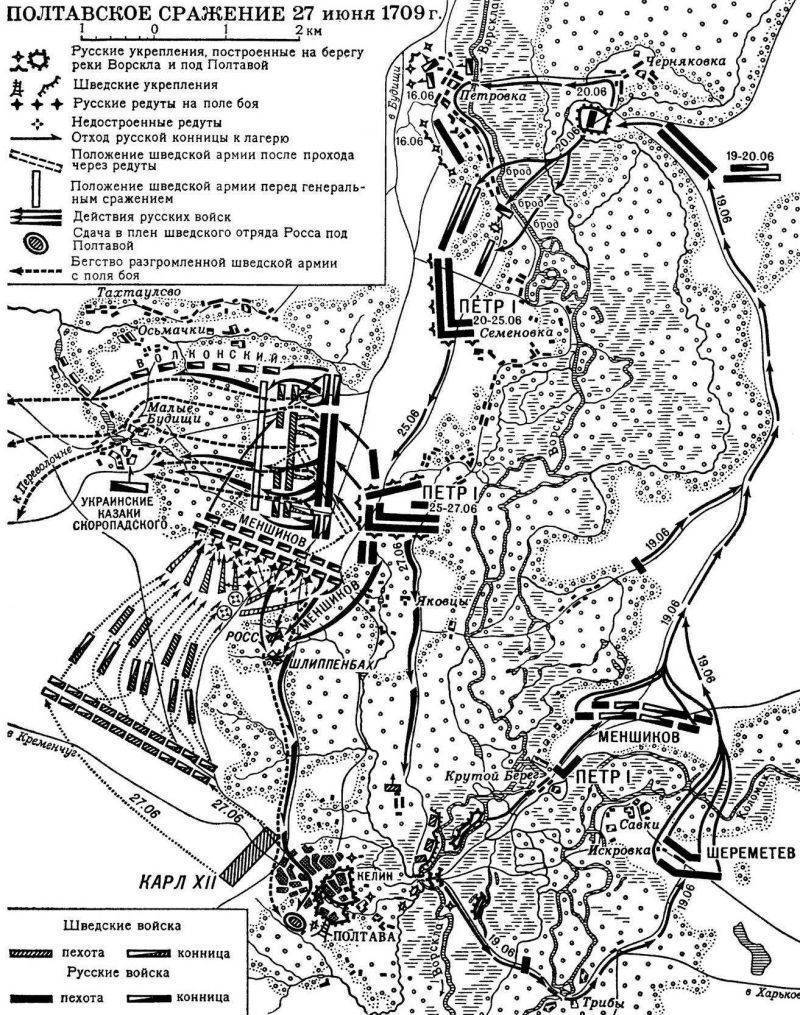
The forces of the parties
At the disposal of Tsar Peter in the fortified camp in front of Poltava were 42 thousand regular and 5 thousand irregular troops (according to other sources, about 60 thousand people). The army consisted of 58 infantry battalions (infantry) and 72 cavalry squadrons (dragoons). In addition, 40 thousand more people were in reserve on the Psyol River. The artillery park consisted of 102 guns.
In the Swedish army, if we proceed from the calculation of casualties and prisoners of casualties under Poltava and Peremovochnaya, as well as those who fled with King Charles, there were a total of about 48 thousand people. Moreover, the number of the most combat-ready forces that participated in the Battle of Poltava was much smaller. About 48 thousand Kozak Mazepins and about 3 thousand Cossacks led by K. Gordienko, who went over to the side of Mazepa and Karl in March 8 of the year, and about 1709 Swedes, who continued to block the Poltava fortress. In addition, the Swedish king, apparently not confident of victory and trying to cover dangerous directions, set up several detachments along the Vorskla River until it fell into the Dnieper at Perevolochny, retaining the possibility of retreat. Also from the participants of the battle is to deduct persons not involved in the combat service: only under Peregrovochnaya prisoners took 1300 "servants". As a result, Karl could put about 3400-25 thousand people and 28 guns. Not all forces participated in the battle from both sides. The Swedish army was distinguished by high professionalism, discipline and won many convincing victories in the lands of Denmark, Saxony and Poland. However, recent failures have greatly affected her fighting spirit.
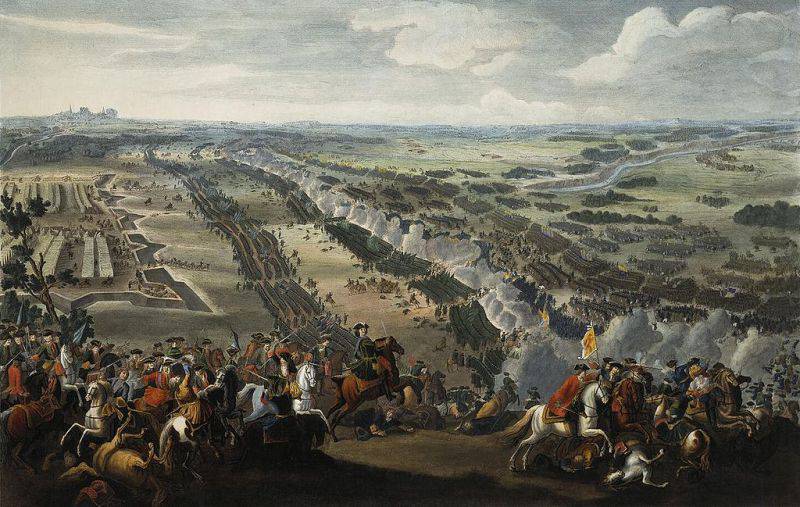
Denis Marten. "Battle of Poltava"
Battle
27 June (8 July) at two o'clock in the morning, the Swedish army under the command of Field Marshal KG Renshild (his bodyguards, the Drabant king, carried on stretchers) with four infantry columns and six cavalry columns secretly moved to the position of the enemy. Karl XII called on soldiers to fight bravely with the Russians and invited them after the victory to the feast in the tents of the Moscow tsar.
The Swedish army moved towards the redoubts and stopped at night in 600 m from the front fortifications. From there came the sound of axes: this is hastily completed 2 advanced redoubts. The Swedes deployed battle lines in 2 in advance: the 1-I consisted of infantry, the 2-I - from the cavalry. Russian horse riding discovered the approach of the enemy. From the redoubts opened fire. Field Marshal Renshild at five o'clock in the morning ordered the attack to begin. The Swedes on the move were able to take two of them who did not have time to complete. The garrisons of the other two offered stubborn resistance. For the Swedes, it was an unpleasant surprise: they knew only about the line of six transverse redoubts. Their assault did not have time to start. The enemy was attacked by the Russian dragoon regiments of generals Menshikov and K.-E. Renne. Swedish cavalry stepped forward infantry, a battle ensued.
The Russian dragoons threw back the royal squadrons and, on the orders of Peter I, withdrew beyond the line of longitudinal redoubts. When the Swedes resumed the attack, they were greeted by strong gun and gun fire from field fortifications. The right flank of the Swedish army, caught in crossfire and suffering heavy losses, retreated in disarray towards the forest near the village of Malye Budyshchi. The Swedish right-flank columns of generals KG Torn off from the main forces during the fight for redoubts Ross and V.A. Schlippenbach defeated the dragoons of General Menshikov.
At about 6 hours Peter I built the Russian army ahead of the camp in the 2 battle lines. The peculiarity of the construction was that each regiment had its own line in the second line, and not someone else’s battalion. Thus, the depth of battle order was created and the support of the first battle line was reliably provided. The center was commanded by General Prince A.I. Repnin. The Tsar laid the general command of the troops on Field Marshal B. P. Sheremetev, who was tested in the war. The Swedish army, which had made its way through the line of redoubts in order to lengthen its battle order, built itself into one battle line with a weak reserve behind. The cavalry was on the flanks in two lines.
At 9 in the morning hours the first line of Russians moved forward. The attack went and the Swedes. After a short mutual rifle fire (from a distance of about 50 meters), the Swedes, not paying attention to the gun and rifle, rushed into a bayonet attack. They sought to get closer to the enemy and to avoid disastrous artillery fire. Karl was sure that his soldiers would knock over any enemy in hand-to-hand combat. The right wing of the Swedish army, in which Karl XII was stationed, pressed the battalion of the Novgorod infantry regiment to which the Swedish 2 attacked. There was a threat of a breakthrough of the Russian position almost at its very center. Tsar Peter I personally led the second battalion of the Novgorodians to the counterattack, which was standing in the second line, which promptly knocked over the Swedes that had broken through, and closed the gap formed in the first line.
During the brutal hand-to-hand combat, the Swedish frontal attack choked, and the Russians began to oppress the enemy. The line of Russian infantry began to cover the flanks of the battalions of the royal infantry. The Swedes panicked, many soldiers ran, fearing encirclement. The Swedish cavalry, without resistance, rushed off into the Budishchinsky forest; followed by the infantry. And only in the center, General Levengaupt, next to whom the king was, was trying to cover the retreat to the camp. The Russian infantry pursued the retreating Swedes to the Budischensky forest and in 11 hours lined up before the last forest mass, hiding the enemy who had fled. The Swedish army was completely crushed and, in an upset composition, fled, led by the king and hetman Mazepa, from Poltava to the crossings across the Dnieper.
Russian casualties were 1345 people killed and 3290 wounded. Losses of the Swedes - 9333 killed and 2874 prisoners. Among the prisoners were Field Marshal Renschild, Chancellor K. Pieper and part of the generals. The 4 cannons and 137 banners, the camp and the convoy of the enemy became Russian trophies.
The remnants of the fleeing Swedish army 29 June (10 July) came to Perevolochne. The demoralized and exhausted Swedes began to search in vain for means of crossing the river. They dismantled the wooden church and built a raft, but it was carried away by the river current. Closer to the night, several ferry boats were found, to which were added wheels from carriages and carts: we had improvised rafts. But only King Karl XII and hetman Mazepa managed to get across to the west bank of the Dnieper with about a thousand people close to them and close protection.
Then Russian troops approached Peregovolno: the Guards Brigade led by General Prince Mikhail Golitsyn, X. NUMX of the dragoon regiments of General R.Kh. Bour and 6 Equestrian and 3 Foot Regiment led by Menshikov. He accepted at the 3 o'clock on the day of June 14 (July 30) the surrender of the Swedish army abandoned by the king, who did not even think about resistance. 11 banner and standard was captured. In all, 142 18 Swedes were captured, almost all of the generals, all their artillery, and the remaining property. King Charles XII and his retinue fled into the possession of Turkey.
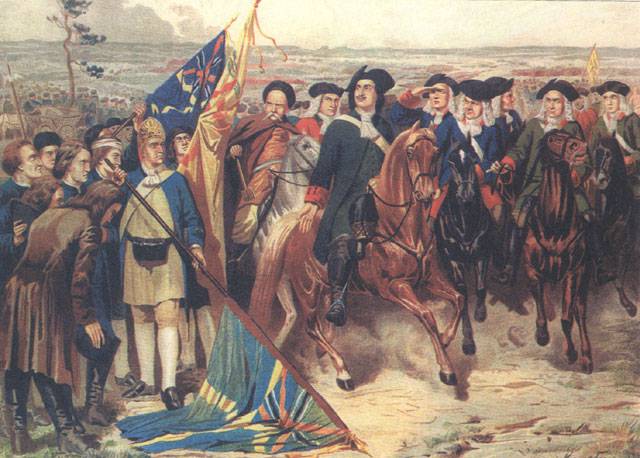
Alexey Kivshenko. "The capitulation of the Swedish army"
Results
The elimination of the most efficient core of the Swedish army had strategic consequences. Strategic initiative in the war completely transferred to the Russian army. The Swedish army was now defending, relying on the fortress, while the Russians were advancing. Russia got the opportunity to win at the Baltic theater. Former allies of Russia in the Northern Union again came out against Sweden. At a meeting with the Saxon Elector Augustus II in Torun, a military alliance of Saxony and Rzecz Pospolita with Russia was again concluded. The Danish king also spoke out against Sweden again.
In Europe, highly appreciated the art of the Russian army in the Battle of Poltava. Russian military art was recognized as advanced, innovative. The famous Austrian commander Moritz Saxon wrote: “In this way, thanks to skillful measures, you can force happiness to lean in its direction.” Rokonkur, a major French military theorist of the first half of the 18th century, advised him to study the commanding art of Tsar Peter I. He wrote the following about the Battle of Poltava: “Such a decisive victory over the best disciplined European troops was not a well-known augury for what the Russians would eventually do ... Indeed, this battle is a new tactical and fortification combination, which would be real progress for both. In this very way, which until then was not used, although equally convenient for an offensive and defense, the whole army of adventurer Karl XII should have been destroyed. ”
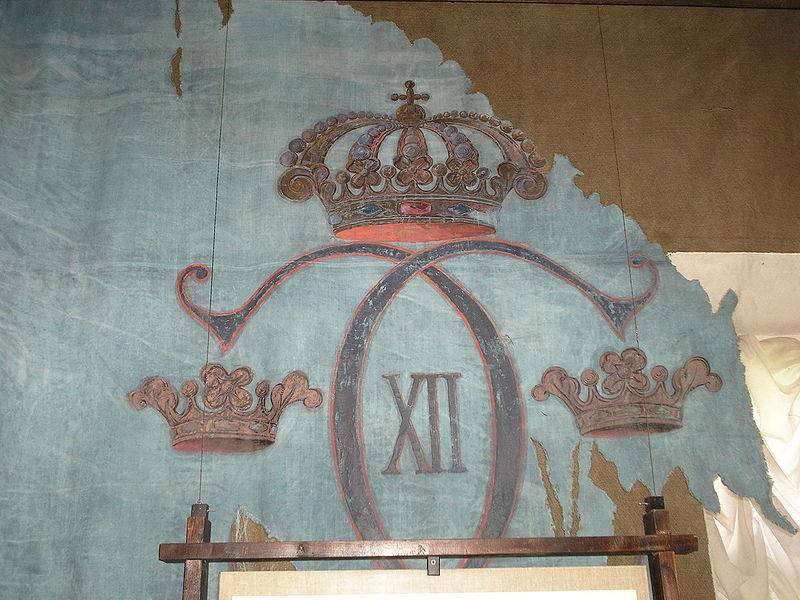
Personal standard of Charles XII, captured during the Battle of Poltava
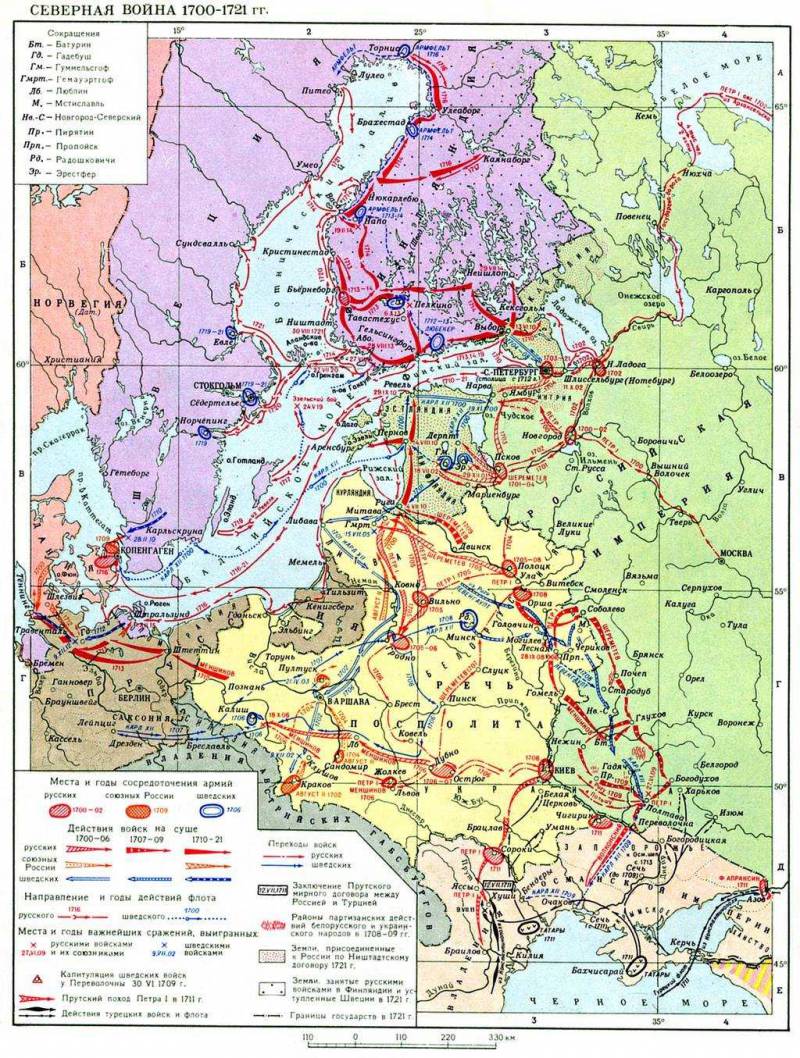
Information